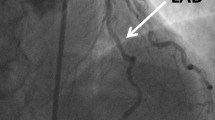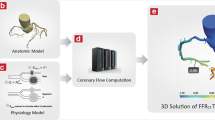Abstract
Purpose
To evaluate the feasibility of fractional flow reserve (cFFR) derivation from coronary CT angiography (CCTA) in patients with myocardial bridging (MB), its relationship with MB anatomical features, and clinical relevance.
Methods
This retrospective study included 120 patients with MB of the left anterior descending artery (LAD) and 41 controls. MB location, length, depth, muscle index, instance, and stenosis rate were measured. cFFR values were compared between superficial MB (≤ 2 mm), deep MB (> 2 mm), and control groups. Factors associated with abnormal cFFR values (≤ 0.80) were analyzed.
Results
MB patients demonstrated lower cFFR values in MB and distal segments than controls (all p < 0.05). A significant cFFR difference was only found in the MB segment during systole between superficial (0.94, 0.90–0.96) and deep MB (0.91, 0.83–0.95) (p = 0.018). Abnormal cFFR values were found in 69 (57.5%) MB patients (29 [49.2%] superficial vs. 40 [65.6%] deep; p = 0.069). MB length (OR = 1.06, 95% CI 1.03–1.10; p = 0.001) and systolic stenosis (OR = 1.04, 95% CI 1.01–1.07; p = 0.021) were the main predictors for abnormal cFFR, with an area under the curve of 0.774 (95% CI 0.689–0.858; p < 0.001). MB patients with abnormal cFFR reported more typical angina (18.8% vs 3.9%, p = 0.023) than patients with normal values.
Conclusion
MB patients showed lower cFFR values than controls. Abnormal cFFR values have a positive association with symptoms of typical angina. MB length and systolic stenosis demonstrate moderate predictive value for an abnormal cFFR value.
Key Points
• MB patients showed lower cFFR values than controls.
• Abnormal cFFR values have a positive association with typical angina symptoms.
• MB length and systolic stenosis demonstrate moderate predictive value for an abnormal cFFR value .





Similar content being viewed by others
Abbreviations
- AUC:
-
Area under the curve
- CAD:
-
Coronary artery disease
- CCTA:
-
Coronary computed tomography angiography
- CFD:
-
Computational fluid dynamics
- cFFR:
-
CCTA-derived fractional flow reserve
- DML:
-
Deep-machine-learning
- LAD:
-
Left anterior descending coronary artery
- MB:
-
Myocardial bridging
- OR:
-
Odds ratio
- ROC:
-
Receiver operating characteristic
References
Forsdahl SH, Rogers IS, Schnittger I et al (2017) Myocardial bridges on coronary computed tomography angiography—correlation with intravascular ultrasound and fractional flow reserve. Circ J 81:1894–1900
Nakanishi R, Rajani R, Ishikawa Y, Ishii T, Berman DS (2012) Myocardial bridging on coronary CTA: an innocent bystander or a culprit in myocardial infarction? J Cardiovasc Comput Tomogr 6:3–13
Dimitriu-Leen AC, van Rosendael AR, Smit JM et al (2017) Long-term prognosis of patients with intramural course of coronary arteries assessed with CT angiography. JACC Cardiovasc Imaging 10:1451–1458
Rihal C, Ammash N (2017) Intramural course of coronary arteries: a bridge too far no more. JACC Cardiovasc Imaging 10:1459–1460
Rubinshtein R, Gaspar T, Lewis BS, Prasad A, Peled N, Halon DA (2013) Long-term prognosis and outcome in patients with a chest pain syndrome and myocardial bridging: a 64-slice coronary computed tomography angiography study. Eur Heart J Cardiovasc Imaging 14:579–585
Li Y, Yu M, Zhang J, Li M, Lu Z, Wei M (2017) Non-invasive imaging of myocardial bridge by coronary computed tomography angiography: the value of transluminal attenuation gradient to predict significant dynamic compression. Eur Radiol 27:1971–1979
Corban MT, Hung OY, Eshtehardi P et al (2014) Myocardial bridging: contemporary understanding of pathophysiology with implications for diagnostic and therapeutic strategies. J Am Coll Cardiol 63:2346–2355
Tarantini G, Migliore F, Cademartiri F, Fraccaro C, Iliceto S (2016) Left anterior descending artery myocardial bridging: a clinical approach. J Am Coll Cardiol 68:2887–2899
Wang Y, Lv B, Chen J et al (2013) Intramural coronary arterial course is associated with coronary arterial stenosis and prognosis of major cardiac events. Arterioscler Thromb Vasc Biol 33:439–444
Ishikawa Y, Akasaka Y, Suzuki K et al (2009) Anatomic properties of myocardial bridge predisposing to myocardial infarction. Circulation 120:376–383
Leschka S, Koepfli P, Husmann L et al (2008) Myocardial bridging: depiction rate and morphology at CT coronary angiography—comparison with conventional coronary angiography. Radiology 246:754–762
Kim PJ, Hur G, Kim SY et al (2009) Frequency of myocardial bridges and dynamic compression of epicardial coronary arteries: a comparison between computed tomography and invasive coronary angiography. Circulation 119:1408–1416
Konen E, Goitein O, Sternik L, Eshet Y, Shemesh J, Di Segni E (2007) The prevalence and anatomical patterns of intramuscular coronary arteries: a coronary computed tomography angiographic study. J Am Coll Cardiol 49:587–593
Gould KL, Johnson NP (2015) Myocardial bridges: lessons in clinical coronary pathophysiology. JACC Cardiovasc Imaging 8:705–709
Tarantini G, Barioli A, Nai Fovino L et al (2018) Unmasking myocardial bridge–related ischemia by intracoronary functional evaluation. Circ Cardiovasc Interv 11:e006247
Kurata A, Coenen A, Lubbers MM et al (2017) The effect of blood pressure on non-invasive fractional flow reserve derived from coronary computed tomography angiography. Eur Radiol 27:1416–1423
Lee HJ, Hong YJ, Kim HY et al (2012) Anomalous origin of the right coronary artery from the left coronary sinus with an interarterial course: subtypes and clinical importance. Radiology 262:101–108
Liu SH, Yang Q, Chen JH, Wang XM, Wang M, Liu C (2010) Myocardial bridging on dual-source computed tomography: degree of systolic compression of mural coronary artery correlating with length and depth of the myocardial bridge. Clin Imaging 34:83–88
Zhang LJ, Wang Y, Schoepf UJ et al (2016) Image quality, radiation dose, and diagnostic accuracy of prospectively ECG-triggered high-pitch coronary CT angiography at 70 kVp in a clinical setting: comparison with invasive coronary angiography. Eur Radiol 26:797–806
Duguay TM, Tesche C, Vliegenthart R et al (2017) Coronary computed tomographic angiography-derived fractional flow reserve based on machine learning for risk stratification of non-culprit coronary narrowings in patients with acute coronary syndrome. Am J Cardiol 120:1260–1266
Solecki M, Kruk M, Demkow M et al (2017) What is the optimal anatomic location for coronary artery pressure measurement at CT-derived FFR? J Cardiovasc Comput Tomogr 11:397–403
Itu L, Rapaka S, Passerini T et al (2016) A machine-learning approach for computation of fractional flow reserve from coronary computed tomography. J Appl Physiol (1985) 121:42–52
Tesche C, De Cecco CN, Baumann S et al (2018) Coronary CT angiography-derived fractional flow reserve: machine learning algorithm versus computational fluid dynamics modeling. Radiology 288:64–72
Kruk M, Wardziak Ł, Demkow M et al (2016) Workstation-based calculation of CTA-based FFR for intermediate stenosis. JACC Cardiovasc Imaging 9:690–699
Tonino PA, De Bruyne B, Pijls NH et al (2009) Fractional flow reserve versus angiography for guiding percutaneous coronary intervention. N Engl J Med 360:213–224
Collet C, Miyazaki Y, Ryan N et al (2018) Fractional flow reserve derived from computed tomographic angiography in patients with multivessel CAD. J Am Coll Cardiol 71:2756–2769
Tesche C, De Cecco CN, Albrecht MH et al (2017) Coronary CT angiography-derived fractional flow reserve. Radiology 285:17–33
DeLong ER, DeLong DM, Clarke-Pearson DL (1998) Comparing the areas under two or more correlated receiver operating characteristic curves: a nonparametric approach. Biometrics 44:837–845
Escaned J, Cortés J, Flores A et al (2003) Importance of diastolic fractional flow reserve and dobutamine challenge in physiologic assessment of myocardial bridging. J Am Coll Cardiol 42:226–233
Halliburton SS, Abbara S, Chen MY et al (2011) SCCT guidelines on radiation dose and dose optimization strategies in cardiovascular CT. J Cardiovasc Comput Tomogr 5:198–224
Agrawal H, Molossi S, Alam M et al (2017) Anomalous coronary arteries and myocardial bridges: risk stratification in children using novel cardiac catheterization techniques. Pediatr Cardiol 38:624–630
Takx RAP, Celeng C, Schoepf UJ (2018) CT myocardial perfusion imaging: ready for prime time? Eur Radiol 28:1253–1256
Dey D, Gaur S, Ovrehus KA et al (2018) Integrated prediction of lesion-specific ischaemia from quantitative coronary CT angiography using machine learning: a multicentre study. Eur Radiol 28:2655–2664
Funding
This study has received funding by The National Key Research and Development Program of China (2017YFC0113400 for L.J.Z.).
Author information
Authors and Affiliations
Corresponding author
Ethics declarations
Guarantor
The scientific guarantor of this publication is Long Jiang Zhang.
Conflict of interest
UJS is a consultant for and/or receives research support from Astellas, Bayer, General Electric, Guerbet, HeartFlow, and Siemens Healthineers. The other authors have no conflicts of interest to disclose.
Statistics and biometry
Meng Jie Lu has significant statistical expertise.
Informed consent
Written informed consent was obtained from all subjects (patients) in this study.
Ethical approval
Institutional Review Board approval was obtained.
Methodology
• retrospective
• observational
• performed at one institution
Rights and permissions
About this article
Cite this article
Zhou, F., Tang, C.X., Schoepf, U.J. et al. Fractional flow reserve derived from CCTA may have a prognostic role in myocardial bridging. Eur Radiol 29, 3017–3026 (2019). https://doi.org/10.1007/s00330-018-5811-6
Received:
Revised:
Accepted:
Published:
Issue Date:
DOI: https://doi.org/10.1007/s00330-018-5811-6




